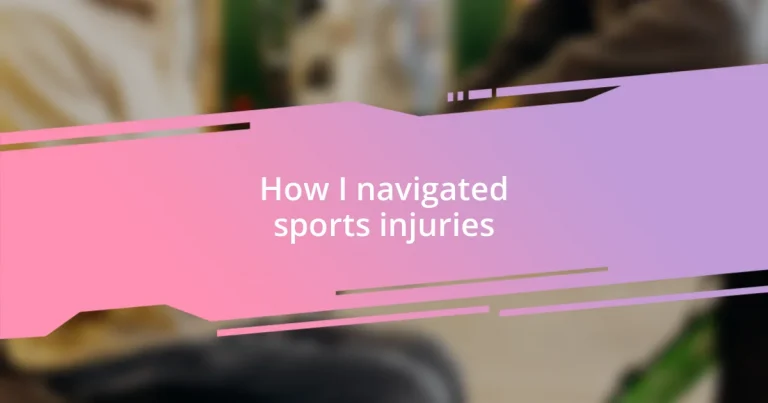Key takeaways:
- Understanding sports injuries involves recognizing symptoms early, applying proper initial care (R.I.C.E.), and knowing when to seek professional help to avoid prolonged recovery.
- A structured rehabilitation program with realistic goals and cross-training can enhance recovery, while preventive measures like proper warm-ups and strength training can significantly reduce future injury risk.
- The psychological impact of injuries includes feelings of isolation and anxiety; fostering a positive mindset and connecting with others can aid emotional recovery and motivation to return to sports.
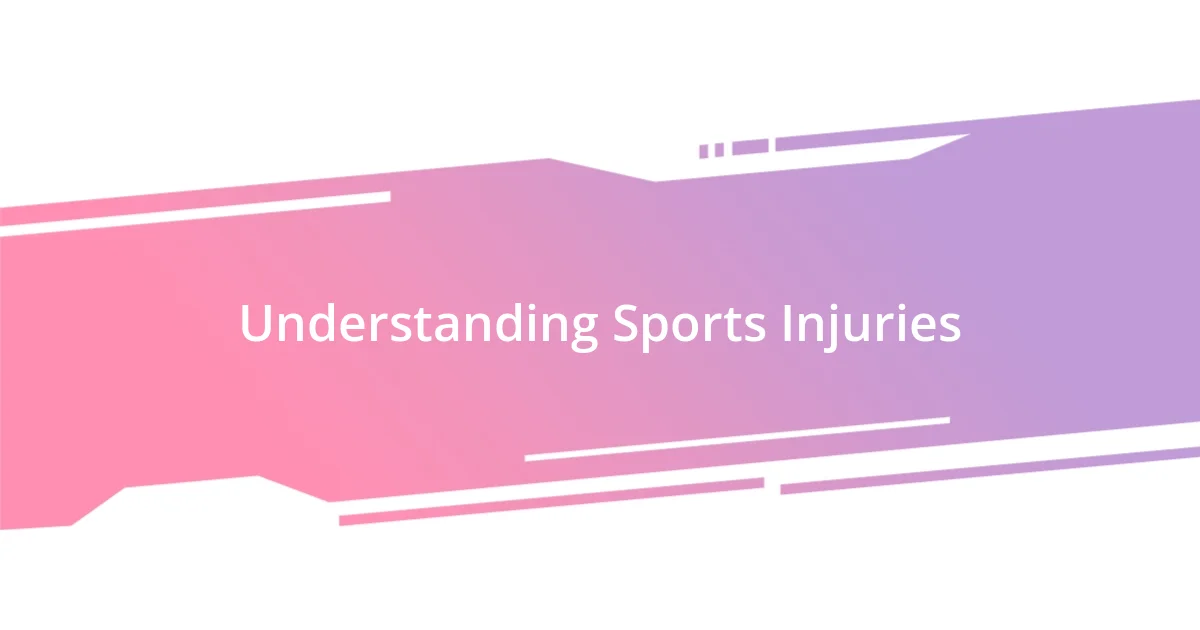
Understanding Sports Injuries
Understanding sports injuries is crucial for both athletes and weekend warriors alike. I’ve faced injuries that felt like a sudden stop sign in my journey, leaving me frustrated and questioning my abilities. When I tore my hamstring during a crucial game, it wasn’t just physical pain—I grappled with the emotional rollercoaster of self-doubt throughout my recovery.
From sprains to fractures, sports injuries can manifest in various ways, influenced by factors like intensity of play, fatigue, and even improper technique. I remember watching a teammate rush back onto the field after twisting her ankle, driven by a fierce desire to help our team. It made me wonder: how often do we choose our passion over our well-being? It’s essential to strike a balance between pushing ourselves and listening to our bodies.
Understanding the mechanisms behind these injuries is equally important. For instance, I learned the hard way that overtraining can lead to stress fractures, a lesson that took time and patience to grasp. Every athlete has their own story; what’s essential is to recognize the signs and listen to those warning signals before they become serious setbacks.
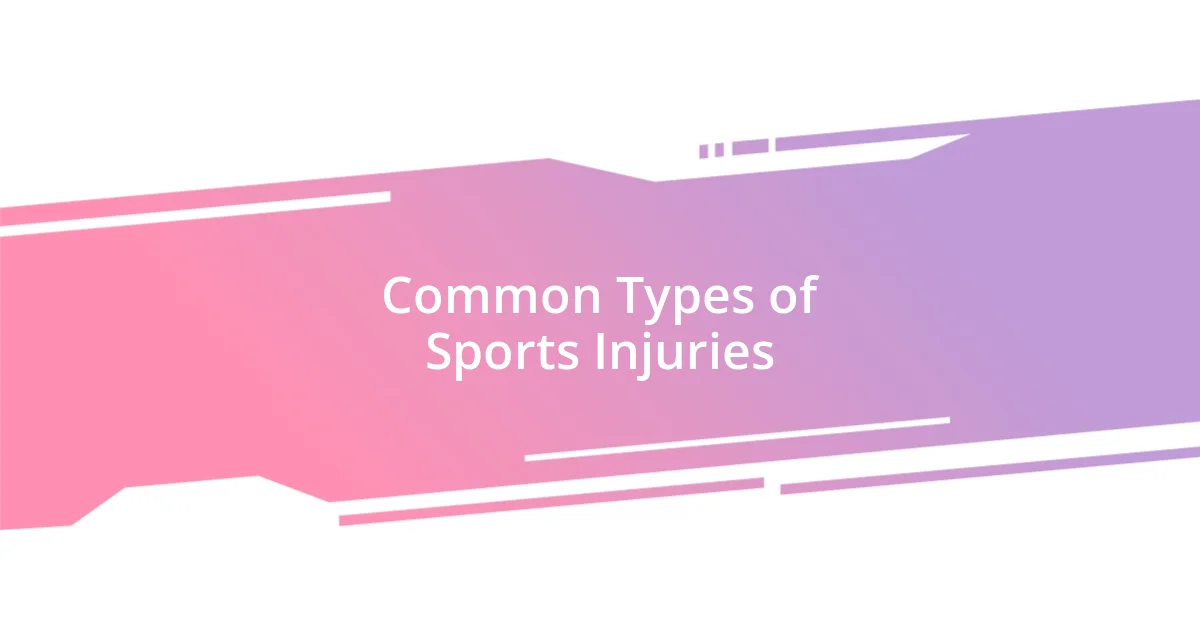
Common Types of Sports Injuries
Common sports injuries can vary significantly, but some are prevalent across different activities. Strains and sprains are often at the top of the list, usually resulting from overstretched muscles or ligaments. I recall the time when I pushed myself too hard during a training session and ended up with a painful shoulder strain. It took weeks to regain my full range of motion—quite the frustrating experience!
Fractures, particularly in contact sports, are another common concern. They can range from stress fractures, often seen in runners, to more severe breaks that require surgery. Once, I witnessed a teammate suffer a break during a crucial match. The atmosphere shifted instantly; it was a stark reminder of how quickly things can change when you’re in the heat of competition.
Lastly, tendon injuries like Achilles tendinitis are frequently overlooked but can sideline athletes for extended periods. After ignoring the initial discomfort in my heel, I found myself limping around for months. It’s a delicate balance; listening to your body is essential, yet, I know firsthand how easy it is to dismiss those early warning signs in the pursuit of our sports goals.
| Type of Injury | Description |
|---|---|
| Strain | Overstretching or tearing of muscles. |
| Sprain | Overstretching or tearing of ligaments. |
| Fracture | Break in a bone, can vary in severity. |
| Tendon Injury | Inflammation or damage to tendons. |

Recognizing Symptoms and Signs
Recognizing the symptoms and signs of a sports injury can be challenging, especially in the heat of competition when adrenaline is running high. I remember feeling a twinge in my lower back during a sprint, but I shrugged it off, thinking it was just a temporary discomfort. However, the subtle signals like swelling, bruising, or prolonged pain are crucial indicators that shouldn’t be ignored.
Here are some specific symptoms to pay attention to:
- Persistent pain in a joint or muscle
- Swelling or tenderness in the affected area
- Reduced range of motion or flexibility
- Bruising that appears shortly after an injury
- A popping sound or sensation at the moment of injury
It’s easy to dismiss these signs, particularly when you’re passionate about your sport. I learned this the hard way after pushing through what I thought was a minor shoulder tweak. Days turned into weeks, and that ‘minor’ issue spiraled into something much more serious. Trust me, understanding these signs early on can make all the difference in avoiding prolonged recovery.
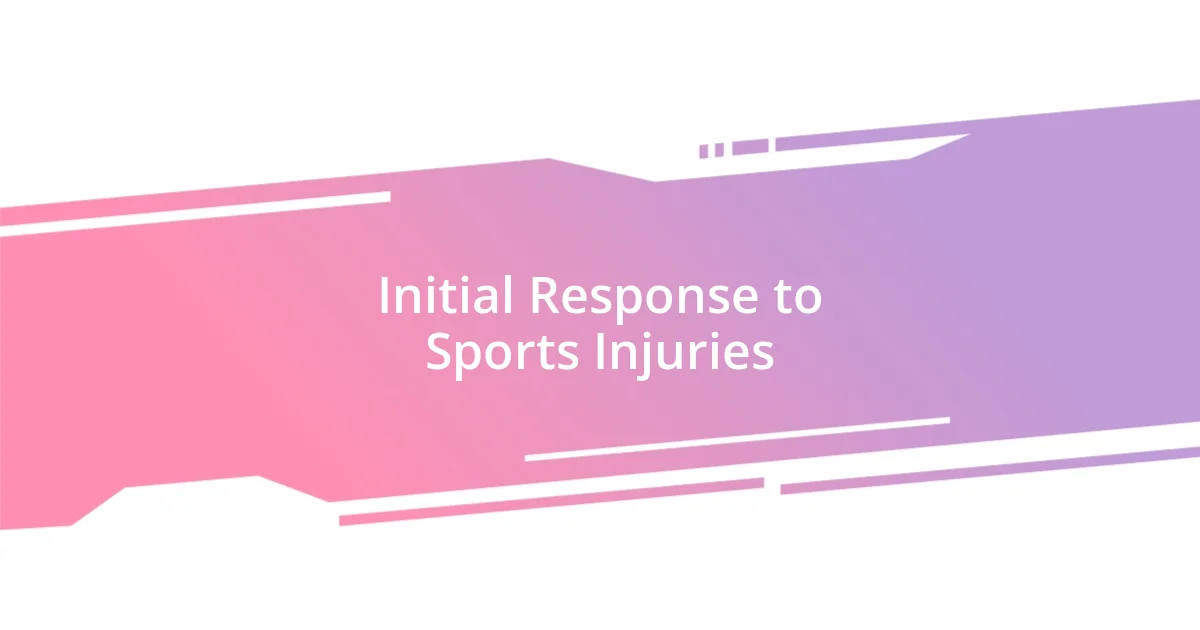
Initial Response to Sports Injuries
When a sports injury occurs, my immediate instinct is to assess the situation. It’s critical to remain calm; emotions can run high, especially when the adrenaline pulses through your veins. I vividly recall the moment I twisted my ankle while playing basketball. I felt a sharp pain shoot up my leg, and my heart sank. In that instant, I had to decide: push through the pain or seek help.
The first step in my response is always to apply the R.I.C.E. method—Rest, Ice, Compression, and Elevation. For example, after my ankle injury, I immediately sat down and raised my foot, hoping to limit swelling. Even as I sat there, the throbbing pain made it hard to focus on anything else. I often wonder, how many athletes overlook this crucial initial step? It’s so easy to get caught up in the moment and ignore proper care.
Recognizing the moment when to seek medical attention is equally important. After a few days of using R.I.C.E., if things haven’t improved, it’s time to consult a professional. I learned this the hard way when I waited too long to get my shoulder examined. The initial strain could have been a simple fix, but procrastinating turned it into a lengthy recovery. It’s tempting to hope for the best, but I can assure you that facing the reality of an injury head-on is always the wiser choice.
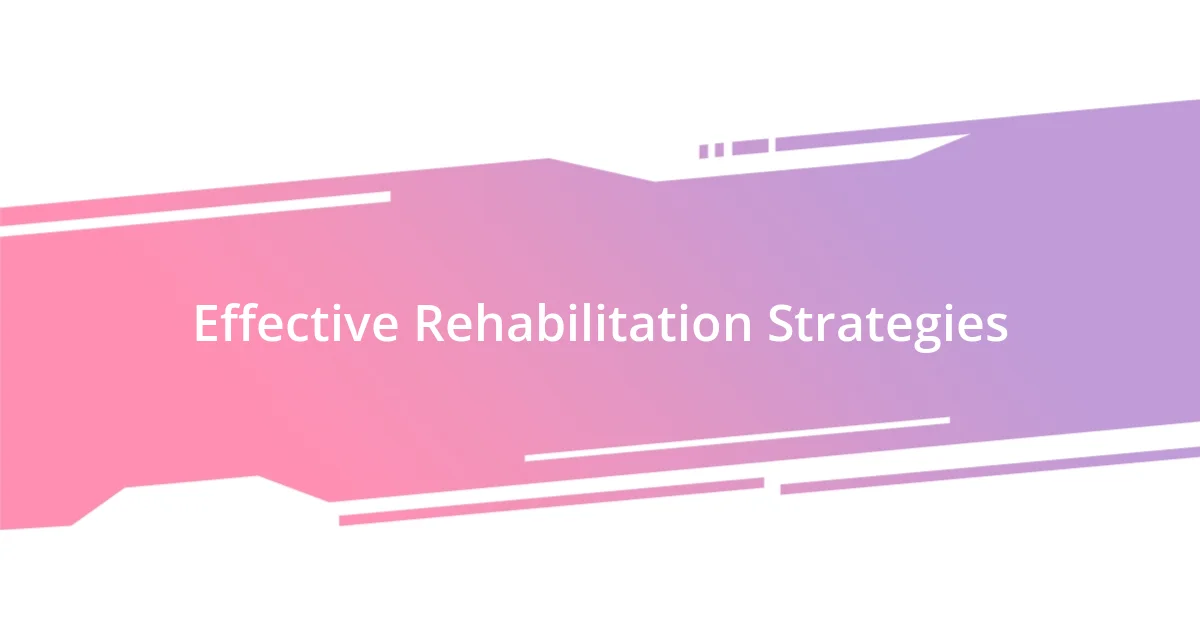
Effective Rehabilitation Strategies
In my experience, a structured rehabilitation program is crucial for a successful recovery. After my knee surgery, I was eager to return to the field, but I learned that pacing myself was key. I remember feeling frustrated during those early weeks of physical therapy when every simple movement felt like a monumental challenge. The therapist introduced me to a blend of stretching and strengthening exercises that gradually built my confidence. Isn’t it fascinating how the right guidance can transform our mindset?
Incorporating cross-training into my recovery was a game changer. I found that while my injured leg was regaining strength through targeted exercises, swimming offered a perfect alternative to stay active. It felt liberating to glide through the water without putting stress on my knee. Balancing rest and activity is essential, and I loved discovering new ways to challenge myself without exacerbating my injury. Have you ever experienced the thrill of finding a new passion amidst a setback?
Finally, setting realistic goals played an integral role in my rehabilitation journey. At first, I aimed for the grand target of returning to competitive play within weeks, but I quickly realized the importance of smaller, achievable milestones. Each completed exercise or increased range of motion became a personal victory. I still remember the elation I felt when I could finally jog for the first time after my injury. How rewarding is it to see tangible progress built on patience and dedication?
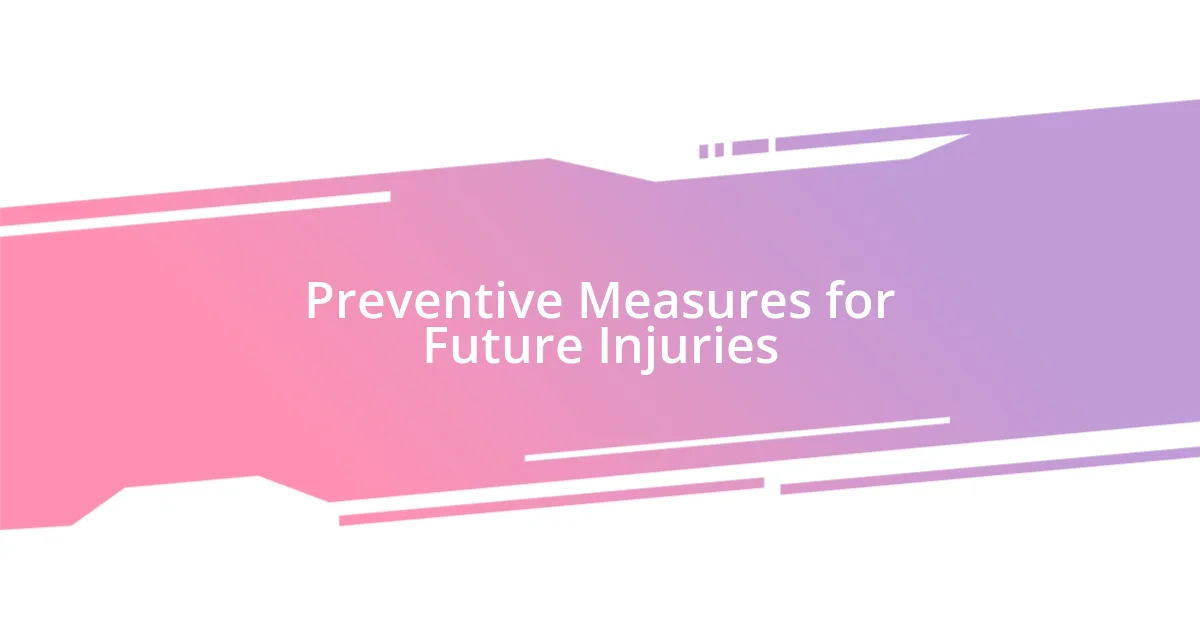
Preventive Measures for Future Injuries
It’s surprising how much focus on preventive measures can significantly reduce the risk of future injuries. After my experiences, I began prioritizing proper warm-up routines before any physical activity. I remember one particular day, not taking my stretches seriously, and ended up straining my hamstring. That lesson taught me that investing those few extra minutes can go a long way in keeping injuries at bay. What’s your go-to warm-up method?
Another critical aspect I discovered is the importance of listening to my body. Early on, I’d often push through pain, convinced it was just part of the game. However, after a couple of setbacks, I learned to distinguish between mild discomfort and signals of an impending injury. For instance, during one particularly grueling training session, my knee felt off, but I shrugged it off. Only later did I realize that acknowledging those subtle hints could have spared me weeks of recovery. Have you ever ignored your body, only to regret it later?
Incorporating strength training has become a staple in my routine as a preventive measure. I still vividly recall the moment I added resistance exercises targeting my core and lower body, which made a significant difference in my stability and performance. Focusing on building strength not only supports my joints but also boosts my confidence in my movements. It’s fascinating how one change can enhance my overall athleticism. Isn’t it empowering to know that with commitment, we can actively shape our level of resilience?
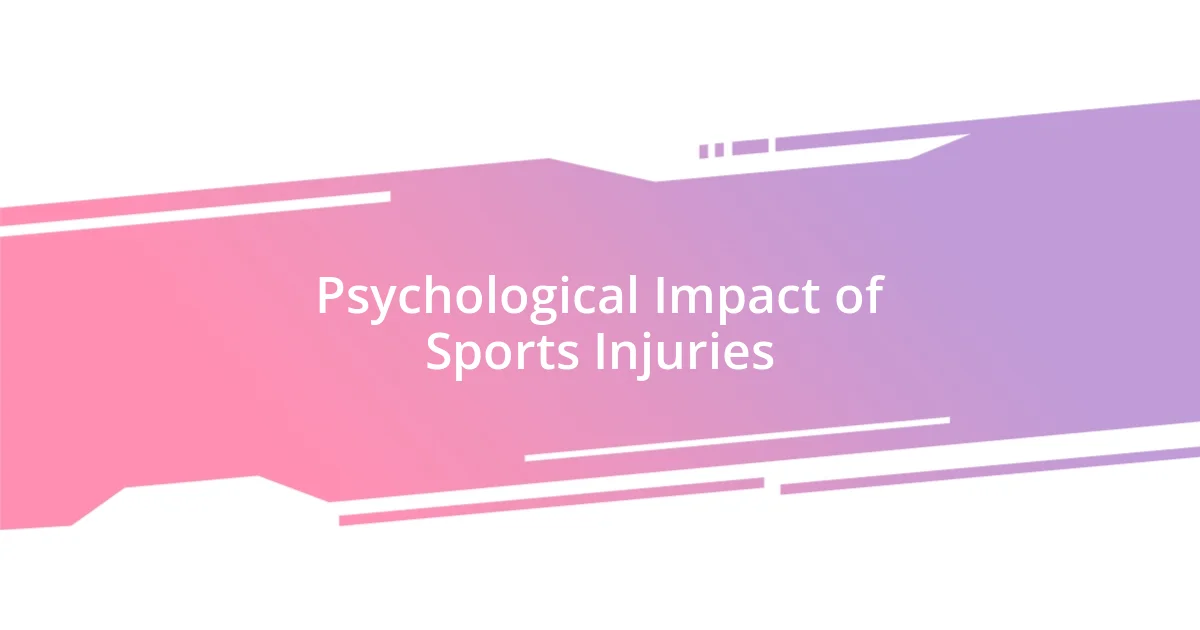
Psychological Impact of Sports Injuries
The psychological impact of sports injuries often runs deeper than what meets the eye. When I faced a significant ankle injury, it wasn’t just the physical pain that affected me; it was the feeling of isolation and helplessness. I found myself grappling with anxiety, questioning my identity as an athlete. Have you ever felt like your self-worth was tied to your performance? It’s a tough realization to navigate.
Rehabilitation became a mental battle, not just a physical one. There were days when the thought of returning to my sport seemed overwhelming, and I often battled negative thoughts. I remember talking it out with a friend who had been through similar struggles, and that support was crucial. Sharing those fears made me feel less alone and helped me see the light at the end of the tunnel. How powerful is it to connect with someone who truly understands what you’re going through?
As I progressed, I discovered the importance of a positive mindset. Visualization techniques became a part of my daily routine; I imagined not only my recovery but also the thrill of being back in the game. I could almost hear the crowd cheering again! This shift in perspective helped me stay motivated through the challenges. Have you ever imagined overcoming an obstacle and found that it spurred you on? Embracing this mental aspect of recovery was a game changer for me.












